#Story Structure
Explore tagged Tumblr posts
Text
How to Structure a Oneshot That Hits Like a Thunderclap
“A good oneshot is a single breath—sharp in, slow out.”
A oneshot isn’t just a short story. It’s a moment, a mood, a slice of intimacy that wouldn’t survive being stretched into a full-length fic. Here’s how to make it count.
Pick One Core Emotion
Build the whole thing around a single feeling. Obsession. Longing. Regret. Euphoria. Grief.
If a full-length fic is a symphony, your oneshot is a single piano note.
Ask: What should the reader feel when they finish?
Ex: “This oneshot is about the moment someone realizes they’ve already fallen in love.”
Limit the Timeline
Don’t span days. Or even hours, if you can help it. The strongest oneshots focus on a single scene or moment.
A kiss in a hallway.
A final goodbye at dawn.
A confession said too late.
Tight time = tight tension.
Start Late, End Early
Drop us into the scene already in motion—no lengthy set-up. And leave us just after the climax, not long after.
Don’t: “They met three years ago and…”
Do: “It’s raining the night he finally says it.”
Your oneshot should feel like eavesdropping on something private.
Structure Like This
ACT I: Setup (15–25%)
Who are we with? Where are we? What’s simmering under the surface?
ACT II: The Shift (50–70%)
Something changes. A kiss. A fight. A confession. A memory.
The mood deepens or flips—this is your emotional peak.
ACT III: The Fallout (15–25%)
How does it end? A single line. A final look. A choice not made.
Leave a lingering echo, not an epilogue.
Let Style Do the Heavy Lifting
A oneshot gives you space to lean into voice, imagery, and metaphor. Write like it’s the last thing you’ll ever write.
“He says her name like it’s a prayer, but the gods stopped listening hours ago.”
Mood. Matters.
#writeblr#writing community#writers of tumblr#writing tips#creative writing#vivsinkpot#amwriting#writing advice#oneshot#oneshot advice#fanfic writing#story structure#writing help#short fiction#fic writing#writing inspiration#writing resources#emotional writing#prose craft#oneshot writing#vivwrites
2K notes
·
View notes
Text
🧩 How to Outline Without Feeling Like You’re Dying
(a non-suffering writer’s guide to structure, sanity, and staying mildly hydrated)
Hey besties. Let’s talk outlines. Specifically: how to do them without crawling into the floorboards and screaming like a Victorian ghost.
If just hearing the word “outline” sends your brain into chaos-mode, welcome. You’re not broken, you’re just a writer whose process has been hijacked by Very Serious Advice™ that doesn’t fit you. You don’t need to build a military-grade beat sheet. You don’t need a sixteen-tab spreadsheet. You don’t need to suffer to be legitimate. You just need a structure that feels like it’s helping you, not haunting you.
So. Here’s how to outline your book without losing your soul (or all your serotonin).
—
🍓 1. Stop thinking of it as “outlining.” That word is cursed. Try “story sketch.” “Narrative roadmap.” “Planning soup.” Whatever gets your brain to chill out. The goal here is to understand your story, not architect it to death.
Outlining isn’t predicting everything. It’s just building a scaffold so your plot doesn't fall over mid-draft.
—
🧠 2. Find your plot skeleton. There are lots of plot structures floating around: 3-Act. Save the Cat. Hero’s Journey. Take what helps, ignore the rest.
If all else fails, try this dirt-simple one I use when my brain is mush:
Act I: What’s the problem?
Act II: Why can’t we fix it?
Act III: What finally makes us change?
Ending: What does that change cost?
You don’t need to fill in every detail. You just need to know what’s driving your character, what’s blocking them, and what choices will change them.
—
🛒 3. Make a “scene bucket list.” Before you start plotting in order, write down a list of scenes you know you want: key vibes, emotional beats, dramatic reveals, whatever.
These are your anchors. Even if you don’t know where they go yet, they’re proof your story already exists, it just needs connecting tissue.
Bonus: when you inevitably get stuck later, one of these might be the scene that pulls you back in.
—
🧩 4. Start with 5 key scenes. That’s it. Here’s a minimalist approach that won’t kill your momentum:
Opening (what sucks about their world?)
Catalyst (what throws them off course?)
Midpoint (what makes them confront themselves?)
Climax (what breaks or remakes them?)
Ending (what’s changed?)
Plot the spaces between those after you’ve nailed these. Think of it like nailing down corners of a poster before smoothing the rest.
You’re not “doing it wrong” if you start messy. A messy start is a start.
—
🔧 5. Use the outline to ask questions, not just answer them. Every section of your outline should provoke a question that the scene must answer.
Instead of: — “Chapter 5: Sarah finds a journal.”
Try: — “Chapter 5: What truth does Sarah find that complicates her next move?”
This makes your story active, not just a list of stuff that happens. Outlines aren’t just there to record, they’re tools for curiosity.
—
🪤 6. Beware of the Perfectionist Trap™. You will not get the entire plot perfect before you write. Don’t stall your momentum waiting for a divine lightning bolt of Clarity. You get clarity by writing.
Think of your outline as a map drawn in pencil, not ink. It’s allowed to evolve. It should evolve.
You’re not building a museum exhibit. You’re making a prototype.
—
🧼 7. Clean up after you start drafting. Here’s the secret: the first draft will teach you what the story’s actually about. You can go back and revise the outline to fit that. It’s not wasted work, it’s evolving scaffolding.
You don’t have to build the house before you live in it. You can live in the mess while you figure out where the kitchen goes.
—
🛟 8. If you’re a discovery writer, hybrid it. A lot of “pantsers” aren’t anti-outline, they’re just anti-stiff-outline. That’s fair.
Try using “signposts,” not full scenes:
Here’s a secret someone’s hiding.
Here’s the emotional breakdown scene.
Here’s a betrayal. Maybe not sure by who yet.
Let the plot breathe. Let the characters argue with your outline. That tension is where the fun happens.
—
🪴 TL;DR but emotionally: You don’t need a flawless outline to write a good book. You just need a loose net of ideas, a couple of emotional anchors, and the willingness to pivot when your story teaches you something new.
Outlines should support you, not suffocate you.
Let yourself try. Let it be imperfect. That’s where the good stuff lives.
Go forth and outline like a gently chaotic legend 🧃
— written with snacks in hand by Rin T. @ thewriteadviceforwriters 🍓🧠✍️
Sometimes the problem isn’t your plot. It’s your first 5 pages. Fix it here → 🖤 Free eBook: 5 Opening Pages Mistakes to Stop Making:
#writing#writing advice#writeblr#writers on tumblr#writing tips#writing help#how to write#story structure#writing process#plotting tips#writing guide#writing blog#writing community#writing support#tumblr writing community#writing inspiration#storytelling tips#how to outline#writing resources#novel writing#outline tips#plotting a novel#writing craft#novel planning#write a book#drafting a novel#writing motivation#first draft advice#fiction writing#character arcs
2K notes
·
View notes
Text
While it's a common issue with all the more recent remakes (The Little Mermaid, Snow White, etc) one of the most frustrating parts of the Lilo and Stitch remake is how carelessly it lifts scenes and dialogue word-for-word from the original script. And without any of the original context attached, what they've carried over from the animated film completely clashes with the things that the new writers have changed or removed.

They still keep the setup of the mosquito joke, with Pleakley explaining that they're an "endangered species" so they can't just destroy Earth.
But unlike the original, this doesn't lead to a running gag - Pleakley never sees or even mentions mosquitos again for the rest of the film - nor do we get the final payoff where it's revealed Cobra was the one who told them this (he has no prior contact with the aliens at all in this version).

So now there's no actual reason for how or why the aliens think this, and one of the best jokes from the original film is reduced to a weird throwaway line that makes no sense.

They also keep the scene where Stitch and Jumba destroy Lilo and Nani's house. Only now, it has completely different circumstances leading up to it, and the consequences this incident is supposed to have are completely skipped over.

It doesn't prompt Cobra to take Lilo, nor does it lead to Lilo running away (the closest equivalent happens before this scene) or getting captured, and when seeing the destruction themselves, Nani and the others are just mildly confused at best before they go back to the issue at hand.
So instead of a genuinely devastating culmination of all the film's mishaps, the destruction of the house now serves no purpose in the story and is completely pointless.

Even the music suffers from this, like Nani singing Aloha Oe or Lilo listening to Elvis.
In the first film, these songs tied into the characters' cultural heritage, and the film's running commentary about America's modern day colonisation of Hawaii. But, this being modern Disney, the more political themes are omitted entirely from this version - certainly not helped by the fact that they didn't even bother to cast a Native Hawaiian actress as Nani - and other than playing a few of this songs, the movie downplays Elvis' prominence so much that it never even mentions him by name.
So instead of actually serving the story or themes, there's no deeper meaning or purpose whatsoever behind the songs beyond the fact they're in the animated film, and now they're just included out of obligation.

That's only a few of many, many examples (feel free to share others), but perhaps even moreso than the other Disney remakes, this one really makes you appreciate how layered and well-structured the original film was in comparison.
#lilo and stitch#live action remake#rant post#cobra bubbles#pleakley#jumba jookiba#bad writing#story structure#elvis presley#lilo and nani#plot holes
1K notes
·
View notes
Text
How to Make Your Writing Less Stiff Part 3
Crazy how one impulsive post has quickly outshined every other post I have made on this blog. Anyway here’s more to consider. Once again, I am recirculating tried-and-true writing advice that shouldn’t have to compromise your author voice and isn’t always applicable when the narrative demands otherwise.
Part 1
Part 2
1. Eliminating to-be verbs (passive voice)
Am/is/are/was/were are another type of filler that doesn’t add anything to your sentences.
There were fireworks in the sky tonight. /// Fireworks glittered in the sky tonight.
My cat was chirping at the lights on the ceiling. /// My cat chirped at the lights on the ceiling.
She was standing /// She stood
He was running /// He ran
Also applicable in present tense, of which I’ve been stuck writing lately.
There are two fish-net goals on either end of the improvised field. /// Two fish-net goals mark either end of the improvised field.
For once, it’s a cloudless night. /// For once, the stars shine clear.
Sometimes the sentence needs a little finagling to remove the bad verb and sometimes you can let a couple remain if it sounds better with the cadence or syntax. Generally, they’re not necessary and you won’t realize how strange it looks until you go back and delete them (it also helps shave off your word count).
Sometimes the to-be verb is necessary. You're writing in past-tense and must convey that.
He was running out of time does not have the same meaning as He ran out of time, and are not interchangeable. You'd have to change the entire sentence to something probably a lot wordier to escape the 'was'. To-be verbs are not the end of the world.
2. Putting character descriptors in the wrong place
I made a post already about motivated exposition, specifically about character descriptions and the mirror trope, saying character details in the wrong place can look odd and screw with the flow of the paragraph, especially if you throw in too many.
She ties her long, curly, brown tresses up in a messy bun. /// She ties her curls up in a messy brown bun. (bonus alliteration too)
Generally, I see this most often with hair, a terrible rule of threes. Eyes less so, but eyes have their own issue. Eye color gets repeated at an exhausting frequency. Whatever you have in your manuscript, you could probably delete 30-40% of the reminders that the love interest has baby blues and readers would be happy, especially if you use the same metaphor over and over again, like gemstones.
He rolled his bright, emerald eyes. /// He rolled his eyes, a vibrant green in the lamplight.
To me, one reads like you want to get the character description out as fast as possible, so the hand of the author comes in to wave and stop the story to give you the details. Fixing it, my way or another way, stands out less as exposition, which is what character descriptions boil down to—something the audience needs to know to appreciate and/or understand the story.
3. Lacking flow between sentences
Much like sentences that are all about the same length with little variety in syntax, sentences that follow each other like a grocery list or instruction manual instead of a proper narrative are difficult to find gripping.
Jack gets out a stock pot from the cupboard. He fills it with the tap and sets it on the stove. Then, he grabs russet potatoes and butter from the fridge. He leaves the butter out to soften, and sets the pot to boil. He then adds salt to the water.
From the cupboard, Jack drags a hefty stockpot. He fills it with the tap, adds salt to taste, and sets it on the stove.
Russet potatoes or yukon gold? Jack drums his fingers on the fridge door in thought. Russet—that’s what the recipe calls for. He tosses the bag on the counter and the butter beside it to soften.
This is just one version of a possible edit to the first paragraph, not the end-all, be-all perfect reconstruction. It’s not just about having transitions, like ‘then’, it’s about how one sentence flows into the next, and you can accomplish better flow in many different ways.
4. Getting too specific with movement.
I don’t see this super often, but when it happens, it tends to be pretty bad. I think it happens because writers feel the need to overcompensate and over-clarify on what’s happening. Remember: The more specific you get, the more your readers are going to wonder what’s so important about these details. This is fiction, so every detail matters.
A ridiculous example:
Jack walks over to his closet. He kneels down at the shoe rack and tugs his running shoes free. He walks back to his desk chair, sits down, and ties the laces.
Unless tying his shoes is a monumental achievement for this character, all readers would need is:
Jack shoves on his running shoes.
*quick note: Do not add "down" after the following: Kneels, stoops, crouches, squats. The "down" is already implied in the verb.
This also happens with multiple movements in succession.
Beth enters the room and steps on her shoelace, nearly causing her to trip. She kneels and ties her shoes. She stands upright and keeps moving.
Or
Beth walks in and nearly trips over her shoelace. She sighs, reties it, and keeps moving.
Even then, unless Beth is a chronically clumsy character or this near-trip is a side effect of her being late or tired (i.e. meaningful), tripping over a shoelace is kind of boring if it does nothing for her character. Miles Morales’ untied shoelaces are thematically part of his story.
Sometimes, over-describing a character’s movement is meant to show how nervous they are—overthinking everything they’re doing, second-guessing themselves ad nauseam. Or they’re autistic coded and this is how this character normally thinks as deeply methodical. Or, you’re trying to emphasize some mundanity about their life and doing it on purpose.
If you’re not writing something where the extra details service the character or the story at large, consider trimming it.
—
These are *suggestions* and writing is highly subjective. Hope this helps!
#writing#writing resources#writing advice#writing tips#writing a book#writing tools#writeblr#for beginners#story structure#book formatting
4K notes
·
View notes
Text
So I've written before about how a lot of Arcane s2 is out of chronological order--intentionally, imo--and how this changes the impact of certain moments. But in this post I want to focus on one sequence of events in 2.05 and 2.06.
Let's assume that when Jayce comes back to his own timeline, he goes directly from the Hexgate to the commune to shoot Viktor. I think this is a reasonable assumption--in the commune, he's still "glitching" significantly, he's still pretty fucked up and disoriented, and it doesn't look like he's made a pit stop to shower, treat his wounds, or improve anything on his makeshift brace.
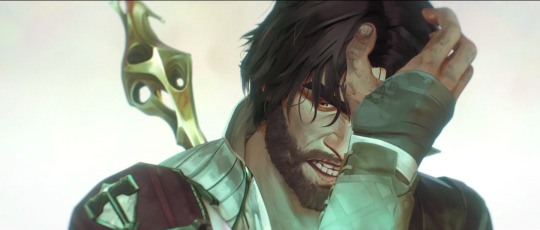
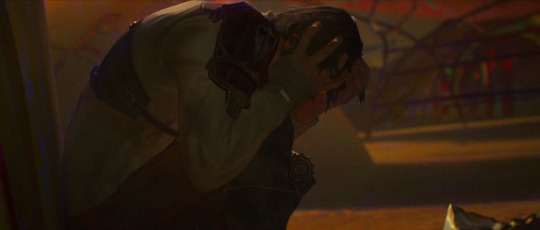
So I think this:
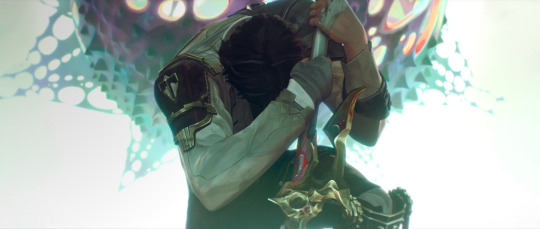
and this:
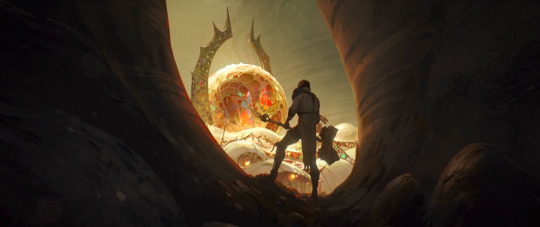
are the same day, maybe only an hour or a couple apart, depending on how long it takes Jayce to make the journey (the exact reverse of what he just did to escape the pit).
We see Jayce come back at the end of 2.05. But! We know that 2.06 takes place over at least two days and a night. Vi, Jinx, Isha and Vader/Warwick arrive in daylight.

They spend at least one night (but possibly many nights) there while Viktor tries to heal Vander.
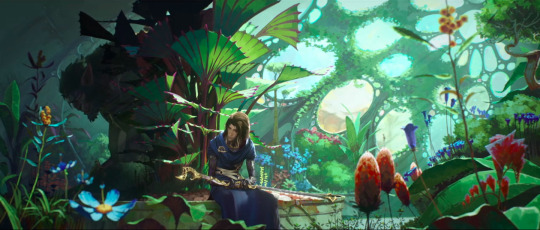
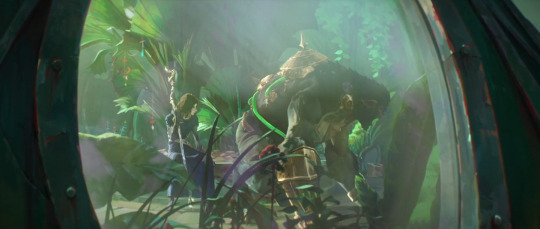
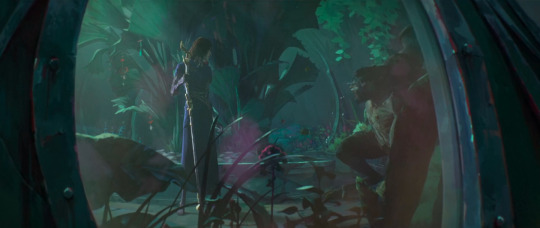
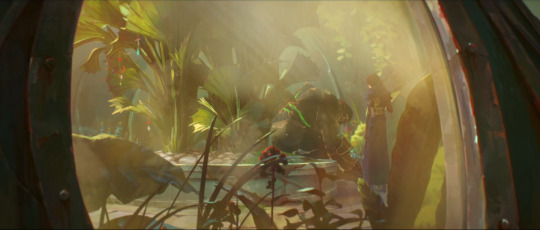
Jayce arrives at the commune in what looks like late afternoon, while Ambessa's forces are also assembled outside, and the ensuing battle runs into the night.
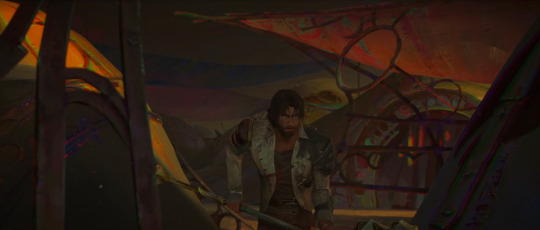
So I think the sequence of events goes like this:
Vi and her family arrive at the commune and meet Viktor. At this point, Jayce has been gone for what seems like months. (My best guess is that Jayce spends something like 2 months in the torment nexus dimension, but he comes back to a point maybe 6-8 months after he disappeared in the main timeline. I think Mage Viktor could have sent him to any point in time and chose that moment specifically, but we don't know that until the end.)
Did Viktor try to contact him in those 6-8 months? Did he think Jayce died? Or maybe he hasn't been trying to seek him out and is doing his best not to think about him.
During a conversation with Jinx and Vi, a gear pops off the water pump, seemingly by chance.
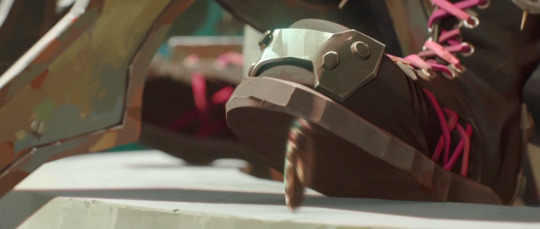
It reminds Viktor of his partnership with Jayce and he starts sentimentally carrying it around.
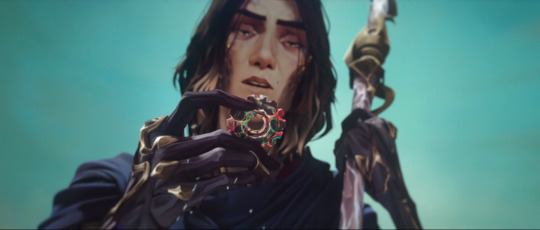
While trying to heal Vander over the course of at least 24 hours, but possibly many days, he becomes aware of just how much his arcane powers are weakening.
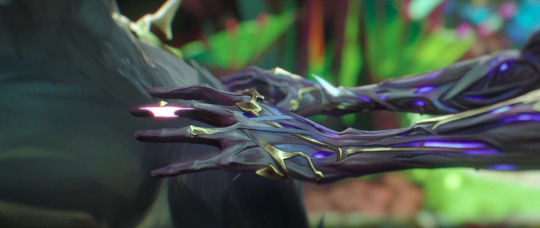
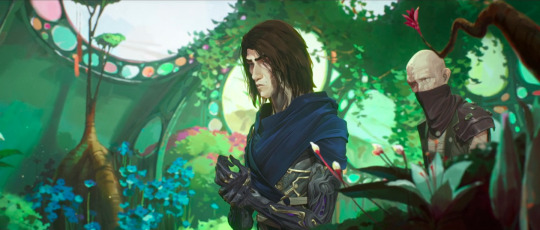
Singed shows up and tries to convince Viktor to use Vander's blood to strengthen his (once again) failing body. Viktor refuses. I think it's at some point on this day--possibly right after this conversation--that Viktor sends Salo to steal the Hexgems, hoping to use them as a power source instead of Vander's blood.
During the conversation with Singed, he sees into Singed's memories and learns that all the doctor's fucked-up experiments have been done out of love for his daughter. Does Viktor suddenly see Jayce's actions in a different light? He's got the gear with him the whole time. Man he sure is thinking a lot about Jayce lately.
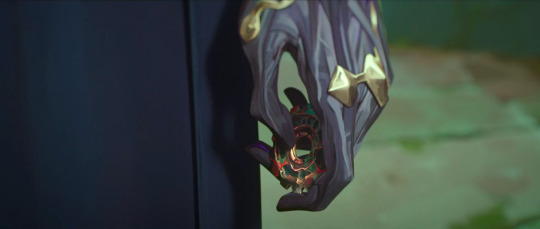
And then all of a sudden JAYCE IS THERE. Almost as if he summoned him. As if the gear was some kind of prophetic talisman. After months of no contact, Jayce is RIGHT THERE in the same room as Salo. Does it feel like...fate?
And ohhh Jayce is fucked up. Something in that guy is deeply damaged, and of course Viktor wants to fix it, that's what he does!
So he invites Jayce to come to the commune and Jayce heads there right away like immediately!! Doesn't even stop to drop his hammer off at home! He shows up that very day, probably mere hours after Viktor invited him!
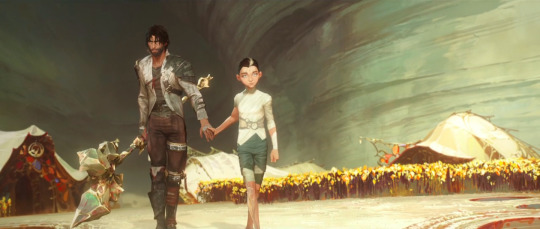
And despite having just observed that there was something weird and off about Jayce, that he didn't seem like himself, despite having just seen him pancake Salo with extreme prejudice...he lets him walk right in. With his fuckoff hammer that probably still has Salo's blood on it! Because it's Jayce and Jayce needs his help and Jayce would never hurt him. Right??
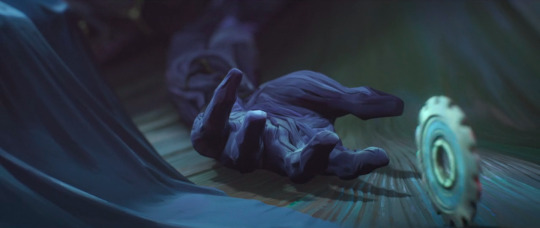
288 notes
·
View notes
Text
Mass Effect 2: The Case for the Heroine's Journey
I have a theory. And I think it's something others--especially other storytellers--might find interesting. It explains why some people absolutely adore Mass Effect 2 while others (not as many, in my experience!) think dealing with all the companions and their personal quests is boring or irrelevant.
What it boils down to is the difference between the Hero's Journey and the Heroine's Journey. There a couple of takes on the Heroine's Journey (ranging from more philosophical and psychoanalytical to more story-based), and I'm going to be pulling hard from the story-based iteration, which author Gail Carriger has written a fabulous book about. I highly recommend it.
One thing I want to mention right off the bat: the gender, sex, or sexuality of your protagonist has nothing to do with whether they're a hero or a heroine.
Everyone and their dog knows the Hero's Journey. A literal ton of writing advice refers to the Hero's Journey as if it's the be-all and end-all of narrative (thanks Carl Jung, Joseph Campbell, and Christopher Vogler); it ain't called the monomyth for nothing.
But if a part of you grits your teeth every time it gets trotted out as The One Right Way to tell a story that sells or a story people love, you may have your mind blown by the concept of the Heroine's Journey. Every single one of you who tingles with excitement at the very thought of found family (or romance, for that matter)? Yeah, strap in, we're going for a ride.
I don't want to go into a lot of detail about the Hero's Journey; it's everywhere. You know it even if you don't realize you know it. So for brevity's sake, I'll give you wikipedia's one-sentence description: a hero goes on an adventure, is victorious in a decisive crisis, and comes home changed or transformed. Luke Skywalker. Everyone always talks about Luke Skywalker. And on the surface, Mass Effect could seem like a Hero's Journey, right?
According to Gail, a Hero's Journey boils down to
A repeated pattern of withdrawal and return, and those withdrawals are voluntary, as voluntary withdrawal and increased isolation yields self-reliant strength.
Victory is in isolation and asking for help is bad.
But looking at it (especially ME2) through the lens of the Heroine's Journey is where it gets interesting.
This is the infographic Gail created and supplies on her website:
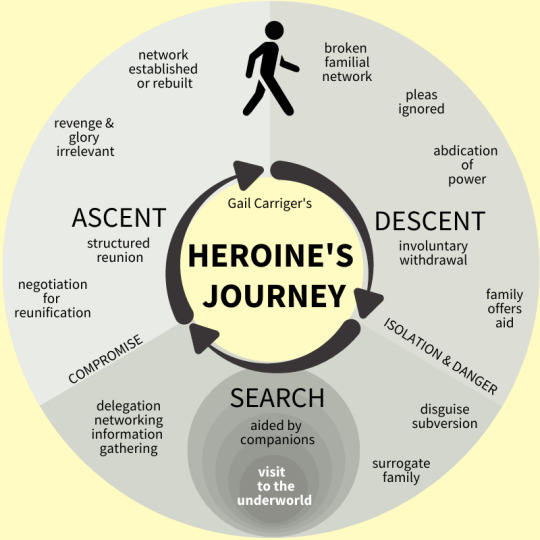
In her book, Gail notes that not every element has to be present to qualify a story as a Hero/Heroine's Journey and the events don't have to happen specifically in this order.
In the Heroine's Journey
The heroine's withdrawal is involuntary; something is broken and she must abdicate the power she had in order to rebuild, retrieve, or reunite with what was taken or broken.
Victory is a group effort; asking for help is a sign of strength; and the protagonist realizes that while she can't do everything herself, she has surrounded herself with people whose skills she can effectively deploy.
In the Heroine's Journey, the DESCENT is involuntary. Something is done to her or taken from her, and it breaks her familial network.
In ME2, obviously, uh, the thing that's taken from Shepard is her own life. Of course, instead of that being the end of the story, it's the inciting incident that leads to the involuntary withdrawal from her found family on the Normandy, her connection to the Alliance, and her Spectre status. Her home is literally destroyed. And then, kinda hilariously, she wakes up in the literal underworld. You know. Cerberus, dog that guards the gates of Hades?
I play a very Paragon Shepard and haven't played Renegade, so I can't speak to that. However, I can tell you that my Paragon Shep wakes up working for Cerberus and promptly proceeds to gain more Renegade points in the first couple of missions--hell, the first couple of conversations with Miranda, Jacob, and TIM--than she got in all of ME1.
Jacob: Do you trust me, Shepard? Shepard: NO, omg.
I've probably played ME2 five or six times with this Shepard, and she always strikes me as a bit off, a bit manic even, until she sees Tali. And she doesn't really start to settle or feel like herself until Archangel takes off his helmet, believes she is who she says she is, and without hesitation agrees to follow her into hell.
(As the protagonist in his own story, Garrus is also a heroine on a Heroine's Journey, by the by. Shepard's death breaks his network; C-Sec and the Council's denial of the Reapers leads to his abdication of power in the hunt for justice. His underworld is Omega. He puts together a surrogate family to fight injustice; he learns to delegate; he doesn't do it for glory... And then Sidonis's betrayal breaks the new family and sends him on another cycle. My theory, however, is that if you let him kill Sidonis, his journey takes on the revenge aspect of a Hero's Journey instead of the family and reunification structure of a Heroine's Journey.)
In ME2, the arc of recruiting an ally, earning their loyalty, and deploying their suggestions to improve the entire team's chances of survival is repeated over and over; this is the SEARCH of the cycle. And anyone who's ever tried to race their way through ME2 without doing all those loyalty missions or without scanning all those planets for resources finds out pretty quick why they're important.
So, while you potentially could race through ME1 without even recruiting several teammates (did you even know you can play that game without recruiting Garrus???), thereby making it much more of a Hero's Journey of the Strength of the Individual, you really can't do that in ME2 without massive casualties. You need the people around you. You need to build relationships. And you need to learn to delegate well, or things will absolutely fall apart during the end run.
Even the stated mission of ME2 is more Heroine's Journey. You're not fighting for glory; in fact, most of the people who used to be in awe of you now think you're a crazy terrorist. You're fighting to stop what's happening to human colonists.
The end run is so satisfying specifically because it leans in to the Heroine's Journey of information gathering and network building. You cannot beat the game as a solitary soldier. You cannot achieve a good outcome--minimal deaths, etc.--without having spent a lot of time and effort gaining the loyalty of your crew and then knowing how to deploy them to best serve the whole team.
ME2 is a story about finding and building a family after the last one is broken.
And though it's a whole other can of worms, I actually think the reason why the ending of ME3 was ultimately so unsatisfying for so many (again, not all) is because the majority of the game is once again a Heroine's Journey--team building and information gathering across the galaxy--but the endgame pulls the expected narrative out from under you. Instead of actually using the resources you've so carefully built, you're quite literally beamed up into complete isolation (weakness) and left to make a choice in isolation. It breaks the narrative promise that's been set up since the beginning of the game. And, whether you realize it or not, that's a huge part of why that lonely choice feels so hollow. Instead of a structured reunion and a rebuilt network, it's actually the broken family and involuntary descent that heralds the beginning of a new Heroine's Journey--not the the end of a successful one.
Also, incidentally? It's Heroine's Journeys that usually get satisfying instead of distracting-the-hero-from-his-real-mission romance, banter, fully realized side characters, and humor.
#mass effect#the heroine's journey#mass effect meta#commander shepard#garrus vakarian#turns out i love heroine's journeys much much more than i like hero's journeys#long text post#story structure#narrative structure#and this is why we get mad when stories don't meet the expectations they've set up#i could talk about this forever but i have a yoga class to get to asap
241 notes
·
View notes
Text
Let's talk about story structure.
Fabricating the narrative structure of your story can be difficult, and it can be helpful to use already known and well-established story structures as a sort of blueprint to guide you along the way. Before we delve into a few of the more popular ones, however, what exactly does this term entail?
Story structure refers to the framework or organization of a narrative. It is typically divided into key elements such as exposition, rising action, climax, falling action, and resolution, and serves as the skeleton upon which the plot, characters, and themes are built. It provides a roadmap of sorts for the progression of events and emotional arcs within a story.
Freytag's Pyramid:
Also known as a five-act structure, this is pretty much your standard story structure that you likely learned in English class at some point. It looks something like this:
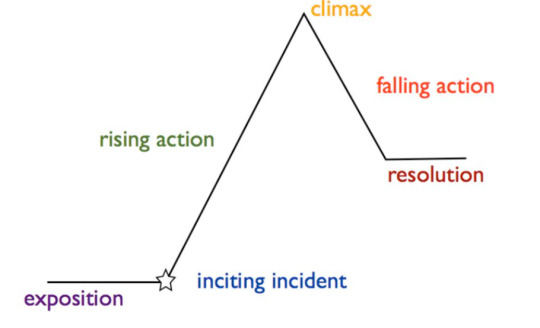
Exposition: Introduces the characters, setting, and basic situation of the story.
Inciting incident: The event that sets the main conflict of the story in motion, often disrupting the status quo for the protagonist.
Rising action: Series of events that build tension and escalate the conflict, leading toward the story's climax.
Climax: The highest point of tension or the turning point in the story, where the conflict reaches its peak and the outcome is decided.
Falling action: Events that occur as a result of the climax, leading towards the resolution and tying up loose ends.
Resolution (or denouement): The final outcome of the story, where the conflict is resolved, and any remaining questions or conflicts are addressed, providing closure for the audience.
Though the overuse of this story structure may be seen as a downside, it's used so much for a reason. Its intuitive structure provides a reliable framework for writers to build upon, ensuring clear progression and emotional resonance in their stories and drawing everything to a resolution that is satisfactory for the readers.
The Fichtean Curve:
The Fichtean Curve is characterised by a gradual rise in tension and conflict, leading to a climactic peak, followed by a swift resolution. It emphasises the building of suspense and intensity throughout the narrative, following a pattern of escalating crises leading to a climax representing the peak of the protagonist's struggle, then a swift resolution.
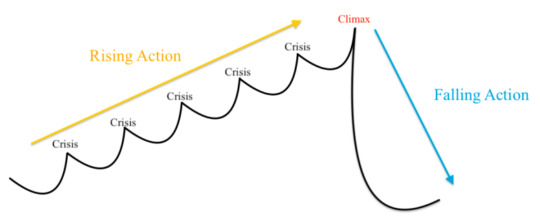
Initial crisis: The story begins with a significant event or problem that immediately grabs the audience's attention, setting the plot in motion.
Escalating crises: Additional challenges or complications arise, intensifying the protagonist's struggles and increasing the stakes.
Climax: The tension reaches its peak as the protagonist confronts the central obstacle or makes a crucial decision.
Falling action: Following the climax, conflicts are rapidly resolved, often with a sudden shift or revelation, bringing closure to the narrative. Note that all loose ends may not be tied by the end, and that's completely fine as long as it works in your story—leaving some room for speculation or suspense can be intriguing.
The Hero’s Journey:
The Hero's Journey follows a protagonist through a transformative adventure. It outlines their journey from ordinary life into the unknown, encountering challenges, allies, and adversaries along the way, ultimately leading to personal growth and a return to the familiar world with newfound wisdom or treasures.
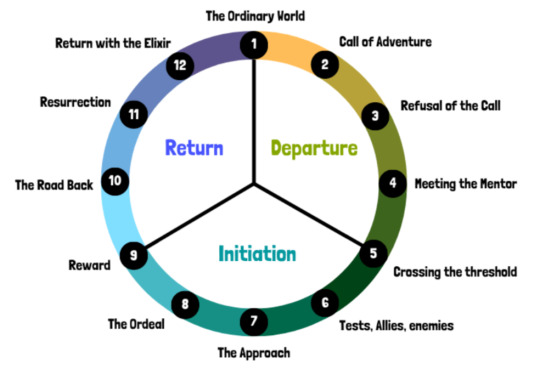
Call of adventure: The hero receives a summons or challenge that disrupts their ordinary life.
Refusal of the call: Initially, the hero may resist or hesitate in accepting the adventure.
Meeting the mentor: The hero encounters a wise mentor who provides guidance and assistance.
Crossing the threshold: The hero leaves their familiar world and enters the unknown, facing the challenges of the journey.
Tests, allies, enemies: Along the journey, the hero faces various obstacles and adversaries that test their skills and resolve.
The approach: The hero approaches the central conflict or their deepest fears.
The ordeal: The hero faces their greatest challenge, often confronting the main antagonist or undergoing a significant transformation.
Reward: After overcoming the ordeal, the hero receives a reward, such as treasure, knowledge, or inner growth.
The road back: The hero begins the journey back to their ordinary world, encountering final obstacles or confrontations.
Resurrection: The hero faces one final test or ordeal that solidifies their transformation.
Return with the elixir: The hero returns to the ordinary world, bringing back the lessons learned or treasures gained to benefit themselves or others.
Exploring these different story structures reveals the intricate paths characters traverse in their journeys. Each framework provides a blueprint for crafting engaging narratives that captivate audiences. Understanding these underlying structures can help gain an array of tools to create unforgettable tales that resonate with audiences of all kind.
Happy writing! Hope this was helpful ❤
Previous | Next
#writeblr#writing#writing tips#writing advice#writing help#writing resources#creative writing#story writing#storytelling#story structure#plot development#outlining#plot structure
530 notes
·
View notes
Text
(Perhaps controversial) theories on Harry Potter first drafts/story structure
I've been reading some more old Harry Potter meta (critique) (damn I miss those LiveJournal esque communities) and after some of the theories I've read I'm now 90% sure that Deathly Hallows was actually the third, or maybe even second book that Joanne started writing.
I love deconstruction and I am a writer, so this kind of thing interests me on a personal level as a high-profile reference that a lot of people might be familiar with, even as generally I have strong critiques for Joanne both as a person, and as what I consider to be something of an impostor in the fantasy genre, as a writer who both openly (at the start of her career) disavowed fantasy classics as beneath her, claimed not to be writing fantasy, and in my opinion, heavily plagiarised works of other authors within the genre and then played ignorant when called out on it by people who by that point had less power and industry clout than she did.
This is going to be critical of JKR, so for those not interested in that, maybe don't read on below the cut. It's not my intention to make anyone feel negative about something that's special or sacred to them.
Some members of the LJ community noted that Deathly Hallows (DH) has many, many recurring references and callbacks to the first book, Philosopher's Stone (PS), with certain characters even seeming to regress to those versions of them in terms of their behaviors, motivations, and what they centrally held as important.
After considering it again I've also come to the conclusion that that's one aspect that throws so many readers off DH as a conclusion to the series, a series that has 'grown up with' the reader and consciously shifted from children's lit to YA; and from a series of fantasy holiday movies helmed by Chris Columbus to a fantasy adventure series with gruesome monsters and wands becoming essentially the ranged weapon variant of lightsabers or the conduit for MCU-esque superhero abilities... that in terms of the writing, the morals, and the overarching themes, actually DH goes backward in that regard to the Roald Dahl-inspired simple morality of the first book where violence was cartoonish, monsters were existential rather than grounded, and Harry and friends were essentially young children trying their best to solve a mystery; rather than the adults the world has contextually by now established them to be.
Joanne has boasted that she had written the Epilogue very early on. What if she had in fact written out a lot of DH very early on?
She knew the books were going to cover (at least) seven school years. I think she decided after the first one, she would write (most of) the end of the series, and then if she needed to, she could write more than 5 other books in between.
DH takes place when Harry isn't in school. But nothing about the story means it has to take place when Harry should be in school.
Thematic and character-based parallels-wise, it might have actually made a lot of sense for Harry to be the same age that his parents were when they passed away, in Deathly Hallows, to make the walk through to the forest with his parents' ghosts, back the same age as they were when he first saw them in the Mirror of Erised more of an exact parallel tearjerker.
And a lot of the criticisms that DH faces - "why didn't we see inside Hogwarts during Snape's regime, and what happened to Neville, Luna and Ginny and the rest of the kids in Harry's year?" - would be nixed if this story was never meant to take place in Harry's final school year.
I suspect that what happened at some point during the height of her fame and blowup is that Joanne realised that a) she was so successful already she wouldn't have to write as many books as she had originally planned; especially because b) movies were now also in the works or being released, and the actors would only be believable as teenagers for a certain duration, but this led to c) now she had a smaller total possible number of books in which to fit all of her vague ideas of where the story would end up going and what the big setpieces were planned to be. (Hence the lengths started to balloon)
I might end up writing a part 2 to this because (ironically) I don't want to make this post so long, but as a starting point I would theorize her original outline may have gone something like the following:
Book 1, Harry Potter and the Philsopher's Stone. Establishes our characters and the main setpieces; Harry Potter, Ron-and-Hermione (who essentially function as a two-headed sidekick machine), Snape, Dumbledore, Voldemort, James-and-Lily-Potter
X number of books, as-yet undefined, at least one per school year, but potentially many more, like most contemporaries to her went in to their careers expecting to write, that expand on the young characters' relationships in small ways, with Draco Malfoy, his foil friends to HRH, and his family, as minor antagonists to drag out the series as long as possible - and never intended as more than that, while Dumbledore and Snape bubble away in the background
Harry's final year of school, in which Dumbledore is killed by Snape in front of Harry at the climax of the year, is buried in the school grounds, and Snape ascends to the Headmaster role
Only then at some point, Voldemort is resurrected and takes pride of place as the main villain, pushing Snape down into the secondary villain/antihero role
The final book in which Harry returns to Hogwarts a la Lord of the Rings/The Empire Strikes back, too late to have a confrontation with Snape (a classic tragic beat) and instead has his showdown with Voldemort, finishing his parents' legacy and completing what they themselves could not do.
I genuinely believe that all of the following were late additions to the story that ended up taking on a life of their own with the fandom, that Joanne never planned for, never really anticipated, and - because we know that she is both stubborn to change in general, and sees herself as a visionary above steer or critique - refused to meaningfully update or edit around in the final version of the last book:
Sirius Black existing at all
Remus Lupin existing at all
Peter Pettigrew existing at all
Fudge, Umbridge, and the Ministry-vs-Dumbledore/Harry sideplot - which, knowing that Joanne is a woman of faith, reeks of a 'skeptical nonbelievers vs true Christians of faith' plot
Luna
Everything about the Triwizard Tournament
Everything about the Yule Ball
Everything about the World Cup (I would go as far as proposing these were originally planned as three episodic books that she ended up blending together)
Spotlight Death Eaters like Barty Crouch and Bellatrix Lestrange
The Founders, the Basilisk, and the Sword of Gryffindor
The Horcruxes
Anything about magical creatures, aside from as episodic flavor to provide a one-off background character
International characters like Fleur, Krum and Madame Maxime
Most fight scenes, including everything with the Dept of Mysteries
Grimmauld Place and Kreacher
And perhaps controversially, most of the racist/blood war elements of the conflict in the books. Because, in DH, apart from flavor description of what the Death Eaters etc. are doing...
The conflict described seems, as it did in PS, to be primarily a personal one, with Voldemort's vendetta being against Harry specifically, and as a proxy, Dumbledore's followers, and people who believed in him and his ideals.
And maybe that's why Harry, the character, never seems to end up caring that much about the foundational principles of why they are fighting the war, and who it is actually there to protect, besides his personal connection with Voldemort as his personal nemesis...
Because Joanne never originally wrote it that way. Voldemort dies, and "all was well."
90 notes
·
View notes
Text
In a way, it’s comforting to tell yourself “I’m stressed” when you’re actually freaked out, anxious, drained by hypervigilance, upset by reading about genocide and the ransacking of our institutions. You tend to be stressed when you’re solving problems and making progress. It’s somewhat less comforting to realize that we’re all trapped in a collective nightmare that none of us can choose, individually, to wake up from.
Our Default Story Structure Is Literally Killing Us (my latest newsletter!)
#writing#quotes#bookworm#trans#transgender#lgbtqia#politics#fantasy#writing advice#story structure#writers on tumblr
58 notes
·
View notes
Text
Why do people struggle so much with understanding pacing?

Okay, let me talk about my pet peeve when it comes to writing in any medium. Pacing.
People, who know me for long, will know that this has been the thing I have been complaining about since I was like 12. And there is a good reason for it.
See, when I learned to write, there was this guy who I greatly admired as an author. And after bugging him for a while (look folks, the internet was a very different place from what it is now) he did give me some recommendations on books on writing. And a lot of them went deeply into his pet peeve, which - you guessed it - was pacing as well.
And thus, I learned early on about story structure, and pacing, and how to pace out a story in a way grips the audience. This material I read went onto different techniques for different mediums, into how different cultures had a different ways of dealing with this, and so on, and so forth.
Some of my main take aways were, that a lot of very long stories struggled massively with pacing, and that a ton of people also very miscalculated their ability to handle characters in terms of pacing - because characters and pacing are two things that are very, very heavily connected.
I also learned something else, though: That a lot of western writing advice did not understand anything about pacing outside of the idea that stories were supposed to have three acts - or maybe five - and ideally from a certain fateful day in the early 2000s on, would follow the "save the cat" formular. (Mind you, I do not hate "Save the Cat", however, this formular has been created for movies. It works at times somewhat well for books, too. But it definitely does not for for pretty much anything serialized, because that is not what it was developed for.)
And I also learned another thing: Most people do not understand pacing either, because pacing is not a thing that is ever taught in normal school (like most things that are about creative writing are not). So, while some people might have a gut feeling that the pacing of something might be off, they rarely can actually say why. And this is only worsened by the fact that today's tiktok addicted society is so used to consuming ultra condensed media, that they will perceive anything less condenses than 1 minute tiktok videos as "too slow and boring".
So, please allow me - the guy who kinda hyperfixated on this specific writing skill - to talk about pacing. And this will be in the following points:
What is pacing actually?
How do characters relate to pacing?
Pacing, Streaming and the supposed "filler episode".
Pacing and Fantasy
Pacing in Action vs anything else
Pacing in books vs visual media
What Is Pacing actually?

Okay, I think one of the main issues when it comes to understanding pacing is, that a lot of people see pacing on a on a spectrum that goes from "I am bored" to "I can't follow the plot anymore". But that actually does not always have to do with the pacing - obviously.
Technically pacing is the speed in which the plot moves. Or, to make it more quantifiable: "How many plot points (beats) are covered per either time (in any timed medium) or per page (in anything you read)". Which makes sense at the first glance - but does actually often not line up with the subjective perception of this. Becau se here is the thing: No, fight scenes are not automatically fast paces. A lot of modern action movies have super slow paced - in terms of story pacing - action scenes. Because yes, during those action sequences a lot of STUFF happens, but nothing of it actually is in any way related to the plot.
Look, I freaking adore the Fast & Furious movies. But you could literally edit those movies down to like 45 minutes each and not lose a single plot beat. But of course, nobody would watch those movies - because yes, me and everyone else who adored those movies, is there to watch them lunch cars into space and see stuff blow up. I don't much care about the characters or the plot.
This is by the way also the kinda point that me and other people talk about, when we are unimpressed by "oh, but sex scenes don't add anything to the plot", while the same people would often not make the same argument about action scenes - even though there is a ton of movies and shows where the action scenes really do not add anything to the plot. A lot of people just do not perceive action sequences as slow pacing, because even if nothing that happens on the screen actually adds anything to the plot or moves it forward, it is undeniable, that STUFF is happening. So basically monkey brain will go: "Hehe, things go boom!"
Don't get me wrong: there absolutely are stories in which the action is moving the plot. Mad Max Fury Road is a great example. The movie is also about 60% action - but the action scenes actually add to the plot.
Meanwhile nothing tells you as much about how unimportant some of the MCU action scenes are, than the fact, that they are often done by a completely different team and will be done apart from the rest of the movie.
But yes, traditionally the idea was, that towards the "finale" of a piece of media, a lot more plot beats would happen over a shorter amount of time. You will see that also in a lot of beat sheets. There are more beats that need to happen in the third act of a story - if we go by three act structure. And often there is actually even more plot developments, as usually in a finale all the "plotlines" will kinda finish up in the end. So even plotlines where not a lot has happened to this point - this shows especially in serialized works both in TV shows and stuff like manga or comics - the important plot points will then often happen close to the finale, because it feels more "right".
In older serialized media - especially TV shows prior to streaming - you also had the same thing hold true towards the finale of a "story arc". In a lot of older shows, you would usually see a structure that looked like this.

The "rise" here technically has less to do with more stuff happening in later arcs or seasons - and more with the threat-level rising, and the convulutedness of a story. lol
But yeah, the take-away from this part should be: No, action does not equal fast pacing. There can be action-heavy shows with super slow narrative pacing - but it will to many not feel this way, because at least action is interesting to watch. Which also might be an explanation to why people are a lot worse in seeing the issue with action-scenes that are not adding anything in visual media, but might actually notice it in written stories. Because in books action scenes do not feel "fast paced" in the same way they feel in movies, where the often faster editing and the amount of motion on screen will create this effect.
Oh, and on the other side: Of course there can be slow paced plots that will leave you having problems following. At times, because they are badly written (aka: the media does not give you all the information you need) - and at times, because a piece of media might expect you to know a certain bit of information that you do not know. I can definitely think of a variety of scifi media, that just expects you to know stuff about computer stuff or space, and will not explain it to you. Which might make you need longer time to take plot developments in, and then leaves you reeling.
Another thing however that is also important is: If the pacing stays actually the same throughout a piece of media - rather than accelarating towards the finale (or finales if there are multiple) - it actually will feel wrong in some way. Often people (even I, who hyperfixates on this specific thing) struggle to point at it at first. But yes, this very much is an issue that also can happen. You want the pacing to accelerate towards certain points in the plot - and then slow down. If you had an important point, you want a few slower scenes/episodes/chapters afterwards, to allow the audience to somewhat absorb all the new things you presented them with.
How do characters relate to pacing?

Alright, now we come to the dicey part - specifically, because a lot of people (which includes narratologists, creative writing professors, and people professionally writing) actually kinda do not fully agree on this. So, fair warning: This is how I think.
A character arc in many cases absolutely is a part of the plot. Most media we consume these days are character driven, so the characters are absolutely centrally connected to the plot and the plot mainly exists to have the character move from point A to point B. Or, to make it more basic: To have a character realize that their WANT is not their NEED.
Sure, those characters will usually also accomplish something plot-related. But them accomplishing them is more often than not heavily connected to them fulfilling their character arc. (Please note: characters having a want but having to realize a need is something that is core of western storytelling. However, given that it makes for interesting character arcs, a lot of Asian media these days also will use this as a central driver for character development.)
In some pieces of media, the character arcs are way more heavily tied into the beats of the main plot, than in other. In adventure, action, and related a lot of fantasy and scifi, there is most of the time a character arc happening parallel to the main plot beats. Meanwhile often enough in more down to earth drama and romance, plot beats and character development beats are heavily interwoven. This is not a hard and fast rule - there absolutely is fantasy where the character arc is the plot arc, just as there is romance where the development does not play as heavily into the main plot - but you can generally observe it.
However, no matter how strongly the character development beats line up with plot beats, you cannot deny one thing: character beats are beats that also add to the pacing - even if they technically do not move the main plot forward. So, for example, if you have an episode in a show or a chapter in a book, where important beats happens in terms of a characters development (for example: they realize something important about themselves), this does not necessarily slow the pacing down - even if no actual plot beats happen.
What the fuck is a plot beat? What is a character beat?

This part of the essay was originally not included, but the people reading over it said I should include this.
If we say, that Pacing is basically the description of "Plot Beats per Time" or rather "Plot Beats and/or Character Beats per Time", then we also need to say, what exactly a Plot Beat is. I will fully admit, that this is one of those things in which I forget that this is not a thing taught in school.
I mentioned "Save the Cat" before. "Save the Cat" is a book about writing movies and specifically about pacing out a movie in a way that it is captivating. It mainly focuses on action, but you can absolutely use it for most other genres. And this comes with a so called "beat sheet", a collection of the main story beats that happen, showing when they are going to happen. It looks like this:
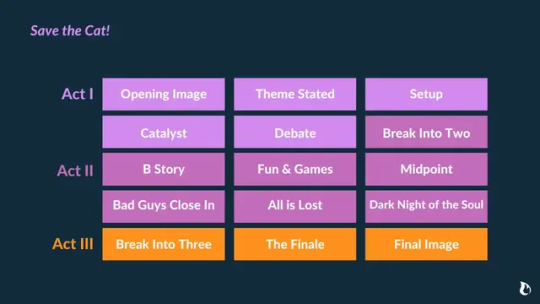
Basically a Beat is a scene, in which the plot (or a character arc) is moved forward by a bit. Basically anything that reveals something to the main characters, anything where the basic assumptions about the plot change, anything like that.
Examples for Plot Beats would be:
Character learns about something going on
Characters find out something important about the plot
Someone (either protagonist or antagonist) gets killed or injured
Characters get a new power or item that is important to the plot
Romance goes forward or a reason for the romance to happen is found
Characters find a hint for something they want to reach
And examples of Character Beats would be:
Character learns something about themselves
Character makes a decision for themselves
Characters realizes feelings about something or someone
Character overcomes trauma
And mind you, because I cannot fit this anywhere else: If you read these you might realize, why Musicals are basically a cheat for very fast pacing. Because you can put an entire character arc into a 4 minute song. This is why musical animated shows like Steven Universe or My Little Pony managed to pull some insanely paced episodes, like the Empire City episodes for SU, and the episode in which the Cutie Mark Crusaders finally got their Cutie Marks. Musicals are insane when it comes to this.
And something that you have to realize: While for movies and books certain Beat Sheets (Save the Cat is not the only one) work rather well, those Beat Sheets usually do not work well for Shows. And currently we are living in a time, where this becomes very noticable - because a lot of modern shows are written and aired as basically 4-8 hour movies, using often just the "Save the Cat" beat sheet (if you have read Save the Cat, you will see it EVERYWHERE, because it is so frequently used in western media), but... obviously, Save the Cat is made for something that has 2 hours, and as such a lot of modern media feels strangely slow and stretched out.
Pacing, Streaming, and the supposed "filler episode"

(Yes, this needed to be the gif for this. Because no filler episode has lodged itself quite as strong into my brain as this one.)
So, let me talk about the issue in modern media. Because oh boy.
As I said: I hyperfixated on this specific writing skill forever - and as such I was annoyed by "filler episodes" in TV shows. To explain for the youngest people (not that I am assuming a lot of those are on this hellsite lol): "Filler" was the name given to material that did not move the plot forward at all. So a "filler episode" was an episode, that was just there to fill the episode slot for the week, while no plot was happening. I am not fully sure whether the term originated with anime - but at least back in the early 2000s, before Shonen-Anime were done as 12-26 seasons that then allowed the manga to get ahead in between, "filler" was also the name used for those story arcs that the anime people made up for shows like Naruto, One Piece or Dragonball, that were not in the manga - and hence obviously also never added to any overarching narrative.
And what can I say: We did not appreciate the filler episode enough. Because this related very much to the last part: While filler episodes did indeed not add to the plot and usually by definition did not the character development, they actually still added something often enough.
They allowed the audience to get to know the characters a bit better and get a better feeling for the character relationships - and those episodes take out a bit of speed, which is actually important.
As said before: The pacing should not be even throughout an entire piece of media. In a TV series after an episode that was especially tense and pushed the plot or characters forward a lot, there should be ideally at least one or two episodes that move forward slower or even not at all. This allows the viewer to sit with the new developments for a bit - and of course the characters to have a moment to breathe and process whatever happened to them.
There is also the fact that those episodes usually give the audience a better understanding for the characters - and if you have an audience who at this point ideally care about some the characters, this will even be more successful.
And as I said. Back in ye olden days, a lot of people - me included - complained so much about Filler. But we were wrong. Fillers are amazing, as long as they do not overtake the whole show.
Pacing and Fantasy

Okay, let's talk about a thing, that is somewhat funny. A lot of fantasy - specifically written fantasy media - often has a pacing problem. And this problem comes from the Worldbuilding. Others forms of fantasy media (other than games - though pacing in games is whole different matter) have this too at times, but it tends to be worst in books.
Basically, when you are a fantasy worldbuilder, you have this whole world. And this leaves you with two problems.
a) You are afraid that people will not be able to follow the plot if you not give them a lot of information about this world and how it differs from ours.
b) Well, you build this entire world. And the people should KNOW.
So, a lot of fantasy media basically regularly will stop to explain to the reader or audience, whatever is happening right now. Some writers manage somewhat naturally put this in. Maybe they have a character that does not know a lot about for example magic or dragons, and they can ask questions and act as an audience stand-in. But even in cases, where the worldbuilding is somewhat brought in naturally (which by far is not all of them - because people usually do not naturally talk about stuff they both know, or think a lot about something they find naturally) those "explanation" pieces will make the plot come to a screeching halt.
So, the more worldbuilding you explain, the slower your pacing is.
And of course, pacing is not a reliable thing to keep people reading, and pacing will not always turn people off. But you know how people complain about how slow Lord of the Rings is? This is because of course, every time that Tolkien describes a piece of landscape over multiple pages, there is no plot happening on those pages. And while I personally think some of those descriptions are darn stunning, it is one of those things many people will not like.
However, this makes it a bit complicated. Because yes, worldbuilding explanations will slow down the pacing to a degree that can be problematic. But if you explain too little worldbuilding, people might struggle to follow the story. Which again is the most common problem if the pacing is "too fast" as well. Basically, people do not properly follow the plot and will struggle to understand what is happening and why.
But the opposite is true as well. I have read way too many fantasy books, where after the first 100 pages, I know a lot about the city the plot is set in, or about the magic system, but sadly have so far not been privy to any information what the plot is about, what the characters try to archive, or even who actually the characters are. And that, yeah... Is probably the most common reason why I put aside a variety of fantasy books in the past.
Pacing in Action-media vs anything else

Okay, let me talk about one other thing. See, the word "pacing" is at times used in some other context: In visual media, pacing will be used for the editing of what we see. Basically the amount of cuts that happen within a scene. Or, in a comic, the distribution of panels is also seen as a pacing element.
And anyone who heard people complain about how at times confusing the editing in action movies is, you know that this at times can get too much.
Still, in visual media action scenes feel usually fast - because the characters are moving around rather fast. In a visual piece of media, action scenes are often thrilling, because the characters are in constant danger of dying, and because a lot of stuff is happening. This often works better in visual media, than in written pieces. While it absolutely is possible to write thrilling action scenes, a lot of writers struggle with this, because they tend to overdescribe and that takes the speed out of the prose. But generally speaking, a couple of punches thrown - something that in a movie takes about 10 seconds - will in book easily end up in 200-500 words, which you will not read quite as fast. A bit more about that later.
And then there is the issue with the action scenes, that even is true for visual medial, is that they often really do not have any important plotbeats. Sure, if the characters have their final battle, that is a plot point. But in a lot of action media - especially TV shows - there are a lot of scenes included that really do not add anything, but just are there because folks love watching action scenes.
This goes so far, that people will think a show or movie with a lot of action scene will just be seen as "good fast pacing", even though if the actual pacing in terms of plot beats being spaced out is rather bad. As a good example I will once more nod at the Fast & Furious and the Mission Impossible movies, that often have horrid pacing and very confusing plots - but they do not feel really like it, because the movies are like 60% action scenes, and hence they do not feel like it when you watch them.
It can work at times. I spoke about my love of the F&F movies. Can I tell you a lot of the characters? Nope, but the action scenes are fun to watch!
But this also tends to mean, that in a badly paced movie or show, that is badly paced because the action scenes not adding any plot beats, everything tends to fall apart when the action scenes do not work. And often enough action scenes will still be prioritized over everything else in many of those pieces of media, making things fall apart easily.
Pacing in books vs visual media

I have hinted at this now multiple times: Written media is generally a bit harder to pace than visual media, because of the things you can and cannot control. While a writer in a book has full control over the scenario, a director of a show or movie had actually influence the timeflow of the things happening on screen. As a writer meanwhile you absolutely have no influence on the speed in which your reader will read.
Sure, you can somewhat influence it. Shorter sentences are easier read. An general lower reading level will allow people to read quicker. So simpler words, shorter words, shorter sentences will make parts appear quicker. You can use this for example in action scenes to have a bit more of this breathless feeling that an action scene on screen might have. Use short sentences. Do not link sentences up. Quick hits. Quick impressions. It can work - but it needs some training. Not to say it is fucking hard.
Generally speaking to my experience when you write a single novel, the "Save the Cat" Beat Sheet actually works rather well, if you are the kind of writer who is fairly good at planning things out. If I actually try, I will usually manage to plan out a story and predict fairly well how many words a chapter will have. So yes, for books I can very much use "Save the Cat" and it will work.
However, some things simply work a lot better when you have visual parts going on - but there are other things you can do better when you do not have the visual stuff. For example: A writer can do much more when it comes to motivation and introspection of characters. Yes, this slows down the pacing - but it is something that writing has basically over any form of media that is not a musical. (In a Musical you can characters do introspection through songs. Musicals are the ultimate way of cheating. I love them!)
Something I feel so many writers struggle with in terms of books is actually putting in a clear goal for the character from the beginning. Again: I have put too many books aside where I reached page 100 and did not yet have any goal for the main character.
That goal you give them does not necessarily need to be their final goal. Again: A lot of western storytelling deals with the incongruent nature of a characters "needs" (aka something that would actually help them) with the character's "wants" (aka what they think they would need). But at the very least the plot needs something that it can head towards from the very beginning - a hook to capture the reader.
There might be readers that are absolutely fine with just reading an exercise in worldbuilding - but you cannot expect them to be.
#writing advice#writing#media criticism#fandom meta#media analysis#writing community#writing tips#writing resources#pacing#storytelling#narrative#story structure#streaming#long post
220 notes
·
View notes
Note
Hey!! I watch you pjmask video, i really like it!! But In pjmask S5 the three og villain teamed up, Will they do the same in your au?
They do not! In my show it goes a bit like
Season 1 - Main heroes are trying to arrest the three (and more, wolfies etc) villains and bring them back to GunnTech. Villains occasionally work together, but there’s always a tension between Romeo and the rest cause Romeo was never experimented on.
Season 2/3 - Slowly realising GunnTech is the bad guy basically, Romeo is getting more ambitious.
Season 4 - Heroes try to leave GunnTech when they realise. GunnTech doubles down and stops putting up a front (except for the public. The public still thinks GunnTech is great). Romeo and Grayson Gunn start working together. Heroes (+ Luna and Nori) are probably locked into the GunnTech facility, put back into their grey uniforms, trying to escape, reflecting on childhood.
Season 5 - Mind control stuff, big finale
352 notes
·
View notes
Text
Plotting vs Discovery Writing: Should You Plan Your Story or Wing It?
Ah, the age-old writer’s dilemma:
Do you map every scene like a tactician drawing battle plans — or dive in with nothing but vibes and a chaotic sense of adventure?
Here’s a breakdown of the pros and cons of both approaches — and why the real magic might lie somewhere in between. 🖋️
Plotting (Outlining / Planning)
Pros:
✔️ Clear direction – You know where you’re going. No getting lost in the woods.
✔️ Foreshadowing magic – You can plant clues, callbacks, and payoff arcs with confidence.
✔️ Fewer plot holes – A roadmap helps spot inconsistencies early.
✔️ Less panic during writing – You’ve already solved some of the hardest narrative problems.
Cons:
✖️ It can feel rigid – The story may resist your outline or outgrow it.
✖️ Planning fatigue – You might lose momentum before the writing even begins.
✖️ Less room for surprise – Characters can feel boxed in by pre-decided fates.
✖️ Too much structure can kill discovery – Sometimes the magic is in what you didn’t see coming.
Discovery Writing (Pantsing / Writing as You Go)
Pros:
✔️ Creative freedom – You’re exploring in real time. Characters can surprise you.
✔️ Organic pacing – The story flows from instinct and mood.
✔️ Emotional authenticity – Moments feel raw, fresh, and true to how they unfolded.
✔️ Writing is more exciting – You’re discovering the story as a reader would.
Cons:
✖️ You might write into a corner – Plot knots are harder to untangle without a plan.
✖️ Revision may be intense – You’ll likely need more editing to fix structure, foreshadowing, and pacing.
✖️ Themes may be muddled – Without direction, your story can lose its core.
✖️ Momentum stalls – Getting stuck is common if you don’t know what happens next.
The Hybrid Approach (A Little Bit of Both)
Plot the skeleton. Discover the heart.
Many writers outline broad strokes (major beats, ending, key twists), but leave space to discover the emotional or interpersonal journey as they write.
You might:
Write a chapter, then outline the next.
Plan major events, but improvise how characters get there.
Start as a pantser, then reverse-outline what you’ve done.
There’s no “right” way — just the one that keeps you writing and enjoying your craft.
Final Thought:
Plotting is a compass.
Pantsing is a storm.
Every writer’s ship sails differently — but the goal is the same: reach the end, and love the journey.
#writeblr#writing community#writers of tumblr#writing tips#creative writing#amwriting#writing advice#tumblrs writers#writing resources#story structure#plotting#pantsing#plotter vs pantser#writing process#story planning#narrative craft#writing methods#writing style#outlining your novel#writing motivation#vivsinkpot#vivwrites
57 notes
·
View notes
Text
What To Do When You Know Your Ending but Have No Clue How to Get There
congrats. you’ve unlocked the most ✨ cursed ✨ form of storytelling: knowing the destination but having zero map, no snacks, and one emotionally unstable protagonist riding shotgun.
aka: you know how your book ends. maybe even the Last Line™. but the middle? the plot? the scenes required to get there?
🦗🦗🦗
welcome to liminal writing hell. here’s what to do about it:
🚨 STEP 1: Write the ending anyway.
yes. even if you’re only on chapter three. write the ending now. not perfectly. not canon. just get it down while it’s burning in your brain.
this does 2 things:
gets you emotionally invested in where you’re headed
gives you a north star to align your scenes to
future-you will thank you when you're knee-deep in act 2, spiraling, and you need to remember what this mess was for.
🧩 STEP 2: Backwards logic it like a feral detective.
ask: what has to happen right before this ending can exist? then ask that question again. and again. until you’ve accidentally built a whole reverse-outline.
like:
✨ final scene: heroine stabs the love interest to save the world → she needs to know he’s the villain → she needs to see him do something unforgivable → she needs a reason to be in the same room as him when it happens → she needs to go to the city where he’s hiding → she needs to choose betrayal over loyalty
now reverse those like breadcrumbs through the forest of chaos.
🎯 STEP 3: Identify your mid-point emotional switch.
the best middles aren’t just “stuff happening.” they’re a turning point. a reversal. a Big Choice. often it’s the opposite of the ending.
ending = character sacrifices love midpoint = character believes love will fix everything
this sets up contrast + emotional stakes. the midpoint shows how wrong they are. the ending proves how far they’ve come.
no midpoint? no tension. build the middle to break them, then rebuild toward the finale.
🧱 STEP 4: Stack up your themes like Jenga blocks.
what are you actually saying with this ending?
if the ending is: “freedom comes at a price” then the story needs to explore:
what freedom means
who pays that price
how people deny the cost
how your protagonist learns to accept it
if your middle scenes aren’t touching these ideas? they’re just filler. start weaving the theme early, subtly, and repeatedly. make it hurt a little.
📦 STEP 5: Write “junk scenes” in the blank spaces.
not sure how they get from castle to climax? write a fake scene. not canon. no pressure. just vibes. let the characters mess around in the setting. argue. kiss. kill. eat soup. whatever.
you’ll learn what they want, what secrets they’re hiding, what tensions spark.
some of these junk scenes will turn out to be real. others will guide you to what needs to happen next. use them as scaffolding.
🧃 STEP 6: Accept that messy = forward.
you won’t always see the whole road. write the next landmark. write the next mistake. write the next bad scene and figure out why it doesn’t work.
knowing your ending is a gift. the rest? that’s the part where you dig.
you don’t need a perfect bridge. you just need enough planks to get across without falling into the river of I’ll-Fix-It-Later.
now go. write the scene where everything breaks.
P.S. I made a free mini eBook about the 5 biggest mistakes writers make in the first 10 pages 👀 you can grab it here for FREE:
🕯️ download the pack & write something cursed:
#writingtips#writingadvice#amwriting#storystructure#fictionwriting#writinghelp#writeblr#authorblr#creativewritingtips#howtooutline#thewriteedvice#wipwoes#thewriteadviceforwriters#writers block#how to write#writers and poets#on writing#writers on tumblr#writing tips#writing#creative writing#writing advice#writing help#how to write a novel#how to outline#writing process#story structure#plotting help#reverse outlining#writerblr
598 notes
·
View notes
Text
Three Act Structure: what's your favorite part?
Act one – Setup. This act lays the groundworks for the story and leads up to the inciting incident (the 'thing' that truly starts the gears of the story). Who are the characters? What world do they live in? What stakes are at play? For example, in the LOTR movies (poll is NOT about LOTR specifically): the introductory monologue all the way up to the Council of Elrond.
Act two – Rising Action & Confrontation. Tensions heighten as the characters are working to reach the goal as set out in act one. It ends with the climax, where the goal is either reached or not. In the LOTR movies: Council of Elrond up until the One Ring is cast into the fire.
Act three – Resolution. Everything that happens after the climax. In what kind of world/state are the main characters left? What happens next?
As an example, consider the Lord of the Rings series:
Act I: Everything from the beginning monologue up until the Council of Elrond
Act II: The Council of Elrond up until the One Ring is cast into the fire.
Act III: Everything after the One Ring is cast into the fire.
–
We ask your questions so you don’t have to! Submit your questions to have them posted anonymously as polls.
#polls#incognito polls#anonymous#tumblr polls#tumblr users#questions#polls about interests#submitted june 20#stories#storytelling#story structure#plot structure#plot#fiction#reading#books
109 notes
·
View notes
Text
Can’t figure out why this scene still isn’t working?
You’ve written and rewritten the same scene five times and convinced yourself to move on to fix it later but it’s still there, still broken, and you can’t put a finger on what the problem is.
You’re in the wrong POV (if applicable)
Your narrator isn’t the best choice here, maybe they’re overshadowing a more important character or their commentary on what’s happening isn’t compelling enough by nature of their relationship with the story.
Your refuse to kill your darlings
You’ve worked so damn hard trying to fit a square peg of this really cool idea in isolation into the round hole that your narrative became. No matter how hard you shove or how many angles you try, it’s not going to work. Delete it, or move it.
This scene occurs at the wrong time
Maybe it’s a revelation that hits too early or too late, either in the physical timeline or within a character’s arc. Maybe it messes up the pacing, leaving characters either rushing or waiting around for the next scene to hit because the placement of your story beats has left clumps and gaps of action.
This scene throws somebody OOC
It might be a darling that needs sacrifice. Maybe it’s the wrong character to have that monologue or to say that cool quip you thought of, or they’re weirdly passionate about a thing that shouldn’t matter to them/nonplussed about something that should be very important to them. It’s something X would never do but you wrote anyway for the sake of the plot.
—
Or some combination of these. My deleted scenes for ENNS’s sequel is officially longer than the existing manuscript purely due to trial and error with my plot.
#writing#writing a book#writing advice#writeblr#writing resources#writing tools#writing tips#story structure#writer problems
602 notes
·
View notes
Text
Since everyone is talking about that concept art of Jayce and Viktor fighting, it's useful to know that the concept artist, Suheb Zako, also posted it on their twitter with some context.
It is early concept art for a final fight between Jayce and Viktor in the hexzone sorry I'm not calling it that astral plane. There's a link in the twitter thread to an anime clip that gives you a sense of what the vibe would've been.
It's not totally clear when in the development/production process this art is from, but I wouldn't be surprised if Jayce and Viktor originally had a dynamic that was more like their game counterparts. In that case a knock-down-drag-out fight in the astral plane might've fit better. But in the final version of the show it wouldn't have worked anywhere near as well as what we got, and not just because it would have seemed out of character for what the characters and their relationship arc became in the finished show.
First of all, we already did have a knock-down-drag-out fight between them. That's the Council chamber fight scene. It would've felt like a repeated beat and that's the last thing you want in your big finale. When you have characters who fight each other multiple times, you want each fight to reflect a progression of their relationship.
Secondly, by the end of the show, Viktor is absurdly overpowered compared to any other character. Once he goes full Machine Herald he is basically a god. A conventional fight scene is just not gonna do it here. You need a twist, some way to win that doesn't involve being stronger than him. And the trump card being The Power of Unconditional Love (And Also This Time Machine Getting Chucked at Your Head) fits perfectly with the show's themes.
Thirdly, the final episode is ALL action. In an episode that's one massive battle, it takes a lot of work to make individual pieces of action stand out. (And generally, you do it not by making the fighting look Super Duper Extra Cool, but with character work.) But any scenes between the characters that are not action are automatically gonna pop because they're so different in pacing and energy from everything around them.
I haven't seen as many people discussing this set of keyframes, but the changes here are also fascinating:

Because Viktor assimilating Jayce as a battle move is almost the complete opposite of what we got in the finished show, and what we got in the finished show is so fucking good. It's one of my favorite moments in the whole damn series.
I've already written about it here, but playing it so that Jayce doesn't get surprised or overpowered but chooses to allow Viktor to bring him into the astral plane as a last-ditch effort to reach whatever is left of Viktor's humanity is sooooooo narratively sexy. (And also just. Sexy. Big stronk dude with his fuckass hammer and his stupid shoulder armor waiting on his knees for his eldritch god bf to materialize behind him and oh so tenderly penetrate his brain with his magic fingers, listen I am not making this up this is just what happens, no homoerotic fight scene could ever top this.)
It also fits with the motif of a number of characters winning their individual battles in the finale by surrender/submission/potential self-sacrifice. It fits with Caitlyn realizing that to cut the string of protective runes off Ambessa's arm she has to allow Ambessa to get within stabbing distance of her face. And of course, Jinx forcing Vi to let her go by popping the gemstone out of her gauntlet and letting herself fall with Warwick.
Arcane has fantastic action storytelling and part of good action storytelling is knowing when to have the character stop fighting each other. Seeing the early concept art is cool to see how much things evolved, but I'm glad they moved away from just trying to do an epic boss fight because what we ended up with is so much more interesting.
#maybe the real boss fight was the cosmic soulmates we made along the way#or something#arcane#viktor arcane#jayce talis#jayvik#concept art#action#story structure#fight choreography
238 notes
·
View notes